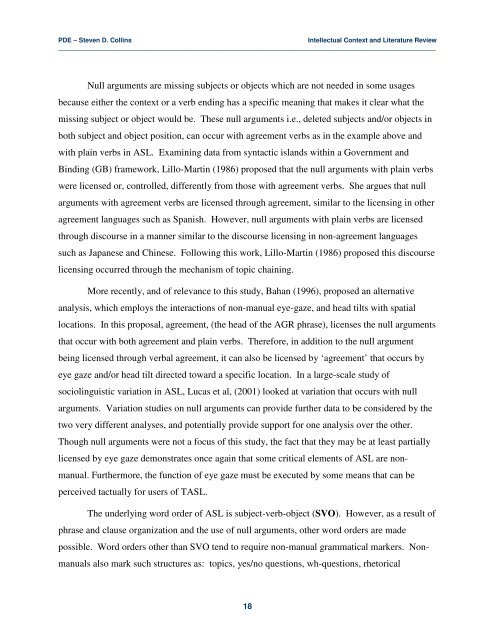Adverbial Morphemes in Tactile ASL - Gallaudet University
Adverbial Morphemes in Tactile ASL - Gallaudet University
Adverbial Morphemes in Tactile ASL - Gallaudet University
You also want an ePaper? Increase the reach of your titles
YUMPU automatically turns print PDFs into web optimized ePapers that Google loves.
PDE – Steven D. Coll<strong>in</strong>s<br />
Intellectual Context and Literature Review<br />
_________________________________________________________________________________________________________<br />
Null arguments are miss<strong>in</strong>g subjects or objects which are not needed <strong>in</strong> some usages<br />
because either the context or a verb end<strong>in</strong>g has a specific mean<strong>in</strong>g that makes it clear what the<br />
miss<strong>in</strong>g subject or object would be. These null arguments i.e., deleted subjects and/or objects <strong>in</strong><br />
both subject and object position, can occur with agreement verbs as <strong>in</strong> the example above and<br />
with pla<strong>in</strong> verbs <strong>in</strong> <strong>ASL</strong>. Exam<strong>in</strong><strong>in</strong>g data from syntactic islands with<strong>in</strong> a Government and<br />
B<strong>in</strong>d<strong>in</strong>g (GB) framework, Lillo-Mart<strong>in</strong> (1986) proposed that the null arguments with pla<strong>in</strong> verbs<br />
were licensed or, controlled, differently from those with agreement verbs. She argues that null<br />
arguments with agreement verbs are licensed through agreement, similar to the licens<strong>in</strong>g <strong>in</strong> other<br />
agreement languages such as Spanish. However, null arguments with pla<strong>in</strong> verbs are licensed<br />
through discourse <strong>in</strong> a manner similar to the discourse licens<strong>in</strong>g <strong>in</strong> non-agreement languages<br />
such as Japanese and Ch<strong>in</strong>ese. Follow<strong>in</strong>g this work, Lillo-Mart<strong>in</strong> (1986) proposed this discourse<br />
licens<strong>in</strong>g occurred through the mechanism of topic cha<strong>in</strong><strong>in</strong>g.<br />
More recently, and of relevance to this study, Bahan (1996), proposed an alternative<br />
analysis, which employs the <strong>in</strong>teractions of non-manual eye-gaze, and head tilts with spatial<br />
locations. In this proposal, agreement, (the head of the AGR phrase), licenses the null arguments<br />
that occur with both agreement and pla<strong>in</strong> verbs. Therefore, <strong>in</strong> addition to the null argument<br />
be<strong>in</strong>g licensed through verbal agreement, it can also be licensed by ‘agreement’ that occurs by<br />
eye gaze and/or head tilt directed toward a specific location. In a large-scale study of<br />
sociol<strong>in</strong>guistic variation <strong>in</strong> <strong>ASL</strong>, Lucas et al, (2001) looked at variation that occurs with null<br />
arguments. Variation studies on null arguments can provide further data to be considered by the<br />
two very different analyses, and potentially provide support for one analysis over the other.<br />
Though null arguments were not a focus of this study, the fact that they may be at least partially<br />
licensed by eye gaze demonstrates once aga<strong>in</strong> that some critical elements of <strong>ASL</strong> are nonmanual.<br />
Furthermore, the function of eye gaze must be executed by some means that can be<br />
perceived tactually for users of T<strong>ASL</strong>.<br />
The underly<strong>in</strong>g word order of <strong>ASL</strong> is subject-verb-object (SVO). However, as a result of<br />
phrase and clause organization and the use of null arguments, other word orders are made<br />
possible. Word orders other than SVO tend to require non-manual grammatical markers. Nonmanuals<br />
also mark such structures as: topics, yes/no questions, wh-questions, rhetorical<br />
18
















